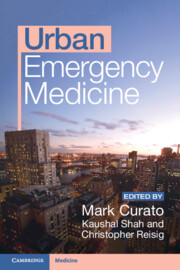Book contents
- Urban Emergency Medicine
- Urban Emergency Medicine
- Copyright page
- Contents
- Contributors
- Preface
- Chapter 1 Caring for the Homeless
- Chapter 2 Disruptive and Dangerous Agitation
- Chapter 3 Penetrating Trauma
- Chapter 4 Substance Use
- Chapter 5 Human Trafficking
- Chapter 6 Travelers from Overseas
- Chapter 7 HIV, AIDS, and Tuberculosis
- Chapter 8 Asthma
- Chapter 9 Physician/Patient Discordance
- Chapter 10 LGBTQIA+ Care
- Chapter 11 Child Maltreatment
- Chapter 12 Care of Vulnerable Elders
- Chapter 13 Civil Unrest: Caring for Police and Protesters
- Chapter 14 Terrorism and Mass Casualty Incidents
- Chapter 15 Overcrowding, Triage, and Care Rationing
- Index
- References
Chapter 15 - Overcrowding, Triage, and Care Rationing
Published online by Cambridge University Press: 20 July 2023
- Urban Emergency Medicine
- Urban Emergency Medicine
- Copyright page
- Contents
- Contributors
- Preface
- Chapter 1 Caring for the Homeless
- Chapter 2 Disruptive and Dangerous Agitation
- Chapter 3 Penetrating Trauma
- Chapter 4 Substance Use
- Chapter 5 Human Trafficking
- Chapter 6 Travelers from Overseas
- Chapter 7 HIV, AIDS, and Tuberculosis
- Chapter 8 Asthma
- Chapter 9 Physician/Patient Discordance
- Chapter 10 LGBTQIA+ Care
- Chapter 11 Child Maltreatment
- Chapter 12 Care of Vulnerable Elders
- Chapter 13 Civil Unrest: Caring for Police and Protesters
- Chapter 14 Terrorism and Mass Casualty Incidents
- Chapter 15 Overcrowding, Triage, and Care Rationing
- Index
- References
Summary
Emergency Departments (EDs) nationwide face overcrowding problems. This is particularly problematic in the urban milieu because of a large volume of patients, smaller physical footprint of EDs, more low-acuity cases, and increased cases needing additional services, such as social services. Overcrowded EDs have negative impacts on patient care and patient safety. There are several solutions to ED overcrowding. Hospital-level solutions include smoothing elective admissions across the week; discharging patients earlier in the day; discharging patients on the weekends; and the Full Capacity Action plan. ED-level solutions include incorporating a Team Triage model; improving radiology turnaround times; improving availability and timeliness of ancillary services; and improving timeliness of consultants.
Keywords
- Type
- Chapter
- Information
- Urban Emergency Medicine , pp. 184 - 190Publisher: Cambridge University PressPrint publication year: 2023

